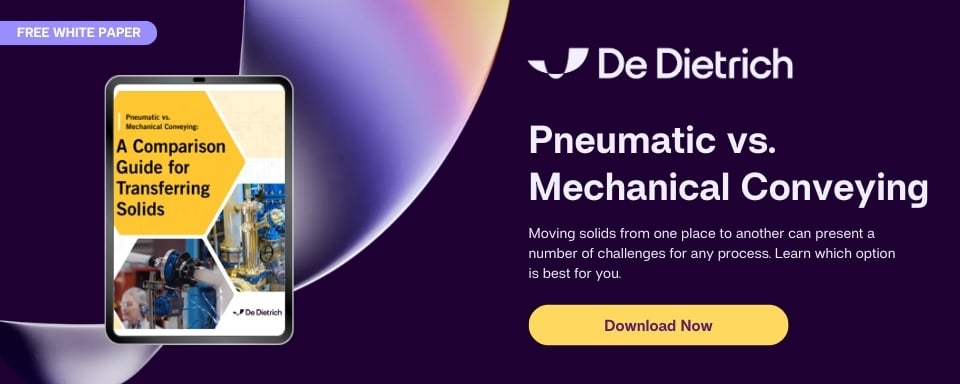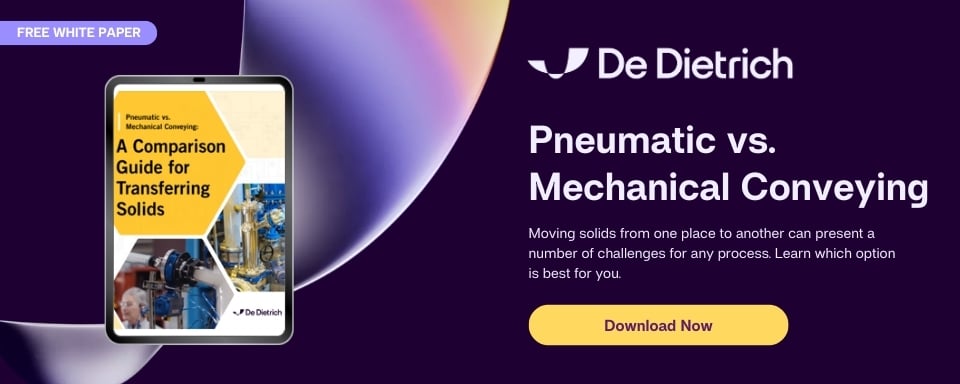Pneumatic Conveying with a Powder Pump System (Vlog)
Jake Davis, Process Engineer at DDPS, discusses Pneumatic Conveying with a Powder Pump System. Watch the video or read the transcript below to learn more.
What is a Powder Pump?
Simply put, the Powder Pump is a pneumatic conveying system used to move product from one point to another point. When De Dietrich Process Systems originally developed the Powder Pump System, our intention was to provide customers with a way to introduce their product or bulk solids into a vessel that has a flammable solvent inside and an inert gas and do so in a way that prevents oxygen or air from getting into that process.
How does a Powder Pump work?
The Powder Pump System operates using dense phase vacuum conditions. We use a vacuum to convey the material. When the material enters the Powder Pump chamber through the transfer line, we isolate the Powder Pump chamber, pull the vacuum a while longer in order to pull out any sort of residual air or oxygen in the product. We follow that step by introducing an inert gas, which is normally nitrogen, and then we discharge the product safely into the vessel. That cycle would repeat until all the material for the batch is charged.
What are the advantages and disadvantages of dense phase vacuum conveying?
Let's start with the advantages. With dense phase conveying, you're operating the system with a higher concentration of solids in the pipeline. What that does is reduce the risk of any dust deflagration occurring within the pipeline itself. Also, with the dense phase conveying system, you're operating the system at a much lower velocity which means your product is moving through the line at a lower speed. That does several things for us:
- Reduces the chance of any sort of static charge being created.
- Reduces the wear and tear on the transfer line itself and the wear and tear on your product.
- Because we operate under a vacuum, if there's a leak in the system, that leak is inward to the system. Conversely, with a positive pressure system, the leak would be external, which could be a very bad thing.
Now, as far as the disadvantages go, we're operating with a vacuum which means we have a fixed pressure differential. That limits us as far as the transfer rates and distances we can achieve.
Are certain types of materials better suited for dense phase conveying?
The short answer is yes. Materials that convey well in our system often have a few things in common. They have a small particle size distribution and their particle shape is consistent and uniform. Some other things that we're looking at are a product's air retention and air permeability characteristics.
So powders, for example, would have good air retention qualities. They're smaller in particle size, which means it locks air inside it much better. So, powders that may be in the 40- to 70-micron range would often move quite well and exhibit a flow that we often call "moving bed" flow.
Alternatively, products like pellets would also move quite well because they have good air permeability, but their flow mode would normally be called "slug" or "plug" flow.
Some products that don't move well have a large particle size distribution and are very irregular in shape. Flakes are a common product that don't move well in a system like ours.
Ultimately, the best way to determine if your product is going to move well in any system is through testing. Testing is something we offer. If you want to find out more information, check out our website or just feel free to reach out to us.
How much would a system like this normally cost?
In our experience, our system normally falls in the middle of the pack. It's definitely going to be more expensive than a simple mechanical conveyor, like a screw conveyor
or an aeromechanical conveyor. On the other end of the spectrum, it's going to be less expensive than a dilute phase system or even a larger mechanical conveying system
like a tubular drag conveyor or a bucket elevator. That being said, one thing to keep in mind would be the fact that most of our systems are installed in hazardous locations,
which inherently means it's going to have a higher price tag.
Can Powder Pumps be used to convey from any type of container?
We can handle pretty much any container that you could think of, whether it be small bags, drums, or super sacks. We develop and design custom systems to handle those types of containers. Our goal is to develop systems specific to our customers' product and their containers. If you need a system like that, feel free to just reach out to us or find out more by looking at our website.
For additional information on this subject, download our new whitepaper: A Comparison Guide for Transferring Solids.

